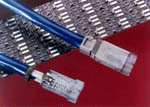 Photo Courtesy of AMP Incorporated
Photo Courtesy of AMP IncorporatedThe grain size of a metal or single phase alloy is an estimate of the average grain diameter, usually expressed in millimeters. The metallurgical techniques used to determine grain size are not necessary for this discussion, the major point to remember is that grain size is an important material characteristic. As the average grain size decreases, the metal becomes stronger (more resistant to plastic flow) and as the grain size increases, the opposite effect on strength occurs. In general, for a given alloy and thickness, ductility increases with grain size and strength decreases. This occurs because the smaller the grains, the shorter the distance dislocations can move. Therefore it is desirable to use metal of the smallest average grain size which can be economically fabricated into the desired part.
In addition to strength, grain size will also effect formability, directionality, texture and surface appearance. Table 1 shows the effect of change in grain size on tensile strength, yield strength and elongation.
| Temper Grain Size | Tensile Strength ksi | Yield Strength (0.5% Ext.) ksi | Elongation in 2.0 inches, % |
|---|---|---|---|
| 0.070 mm | 46.0 | 14.0 | 65 |
| 0.050 mm | 47.0 | 15.0 | 62 |
| 0.035 mm | 49.0 | 17.0 | 57 |
| 0.025 mm | 51.0 | 19.0 | 54 |
| 0.015 mm | 53.0 | 22.0 | 50 |
| Eight Hard | 50.0 | 35.0 | 43 |
| Quarter Hard | 54.0 | 40.0 | 23 |
Table 2 describes some common grain size ranges and their recommended applications for manufacturing parts.
| Average Grain Size, mm. | Typical Operations and Surface Characteristics |
|---|---|
| 0.005 - 0.015 | Stampings and shallow forming. Parts will exhibit good strength and a very smooth surface. |
| 0.010 - 0.025 | Stampings and shallow drawn parts. Parts will exhibit high strenght and smooth surface. Generally used for metal less than 0.010" thick. |
| 0.015 - 0.030 | Stampings, shallow drawn parts and deep drawn parts requiring buffable surfaces. Generally used for metals less than 0.12" thick. |
| 0.020 - 0.035 | Used for many drawn parts. This grain size range includes the largest average grain size which will produce parts essentially free of orange peel. Generally used for metal thickness up to 0.032". |
| 0.025 - 0.040 | Deep drawing especially for material 0.015" to 0.020" thick. Brass with grain size of 0.040 mm may exhibit some roughening of surface when severely stretched. |
| 0.030 - 0.050 | Stampings that do not require buffing or polishing and drawn brass parts with relatively good surface finish. Generally used for metal 0.015" to 0.025" thick. |
| 0.040 - 0.060 | General deep and shallow drawing of brass. Moderate orange peel may develop on surfaces. Normal size range of 0.020" to 0.040". |
| 0.015 - 0.030 0.060 - 0.090 |
Deep drawing of difficult shapes and deep drawing of metal and thicker. Parts will have rough surfaces with orange peel if they are not smoothed by ironing. |
